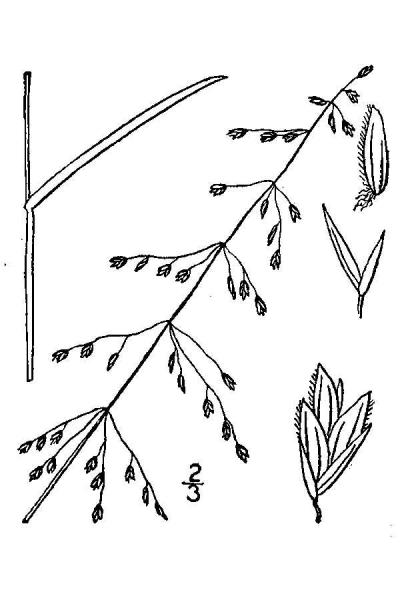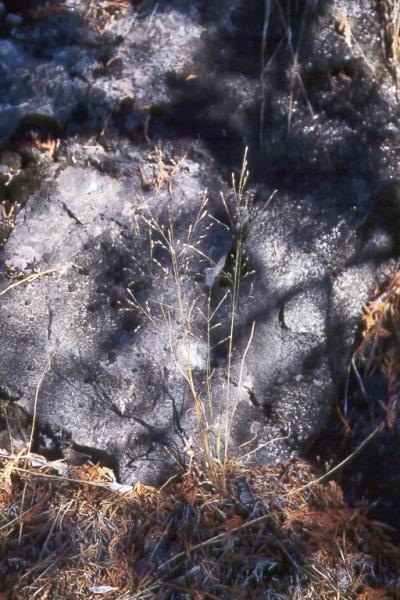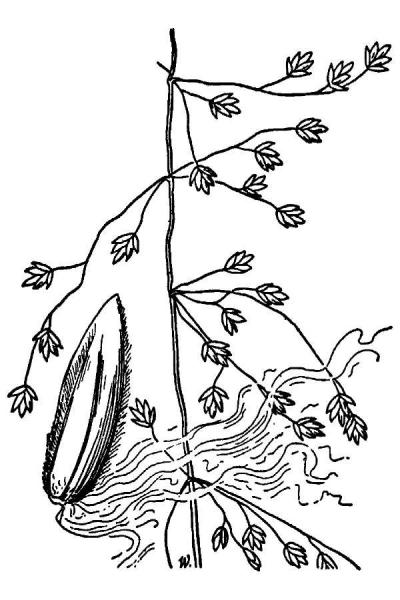Forest Blue Grass
Poa sylvestris Gray
- Class
- Monocotyledoneae (Monocots)
- Family
- Poaceae (Grass Family)
- State Protection
- Endangered
Listed as Endangered by New York State: in imminent danger of extirpation in New York. For animals, taking, importation, transportation, or possession is prohibited, except under license or permit. For plants, removal or damage without the consent of the landowner is prohibited.
- Federal Protection
- Not Listed
- State Conservation Status Rank
- S1
Critically Imperiled in New York - Especially vulnerable to disappearing from New York due to extreme rarity or other factors; typically 5 or fewer populations or locations in New York, very few individuals, very restricted range, very few remaining acres (or miles of stream), and/or very steep declines.
- Global Conservation Status Rank
- G5
Secure globally - Common in the world; widespread and abundant (but may be rare in some parts of its range).
Summary
Did you know?
Woodland bluegrass was first collected in New York in 1848 at Niagara Falls by William Starling Sullivant, the foremost American bryologist of the 19th century.
State Ranking Justification
There are five known populations and at least nine historical populations. Many of these populations are small. As a woodland grass in relatively common habitats, this plant may be overlooked. More survey work that focuses on finding this plant are needed. This species may benefit from a predictive distribution model.
Short-term Trends
The 3 known populations have not been surveyed more than once so we do not know what the short-term trend is. There have probably been as many known populations at one time as there ever was.
Long-term Trends
The known populations have not fluctuated greatly over time. This grass was never common in the state and has persisted at low levels for many decades.
Conservation and Management
Threats
There is not enough data about the known populations to know what threats exist. Two of them occur in populated areas and may be threatened by development.
Conservation Strategies and Management Practices
We think this grass prefers undisturbed habitat so management must provide a sufficient buffer around each occurrence to prevent disturbance.
Research Needs
We need to know more about the habitat preference of this grass to narrow down the places to search.
Habitat
Habitat
A grass found in decidious forests, usually associated with calcareous or other rich soil types (New York Natural Heritage Program 2005). Rich woods (Rhoads and Block 2000). Moist woods (Gleason & Cronquist 1991). Rich deciduous woods (Voss 1972). Rich woods (Fernald 1970).
Associated Ecological Communities
- Beech-maple mesic forest
(guide)
A hardwood forest with sugar maple and American beech codominant. This is a broadly defined community type with several variants. These forests occur on moist, well-drained, usually acid soils. Common associates are yellow birch, white ash, hop hornbeam, and red maple.
- Limestone woodland*
(guide)
A woodland that occurs on shallow soils over limestone bedrock in non-alvar settings, and usually includes numerous rock outcrops. There are usually several codominant trees, although one species may become dominant in any one stand.
- Maple-basswood rich mesic forest*
(guide)
A species rich hardwood forest that typically occurs on well-drained, moist soils of circumneutral pH. Rich herbs are predominant in the ground layer and are usually correlated with calcareous bedrock, although bedrock does not have to be exposed. The dominant trees are sugar maple, basswood, and white ash.
- Rich mesophytic forest*
(guide)
A hardwood or mixed forest that resembles the mixed mesophytic forests of the Allegheny Plateau south of New York but is less diverse. It occurs on rich, fine-textured, well-drained soils that are favorable for the dominance of a wide variety of tree species. A canopy with a relatively large number of codominant trees characterizes this forest. Canopy codominants include five or more of the following species: red oak, red maple, white ash, American beech, sugar maple, black cherry, cucumber tree, and black birch.
* probable association but not confirmed.
Associated Species
- Acer saccharum (sugar maple)
- Carpinus caroliniana
- Caulophyllum thalictroides (blue cohosh, late blue cohosh)
- Fagus grandifolia (American beech)
- Fraxinus americana (white ash)
- Tilia americana var. americana (American basswood)
- Viburnum dentatum var. lucidum (smooth arrowwood)
Range
New York State Distribution
Most records for this grass are from the Great Lake Plains and the morainal hills to the south. There are a few scattered reports in the northern Hudson Valley, but these reports should be verified.
Global Distribution
This grass may be found from New York west to Wisconsin and Iowa, and south to Florida and Texas.
Identification Comments
General Description
This is a clumping grass with an erect, slightly compressed stem up to 2.5 ft. tall. The soft leaves are mostly along the stem and 1/8 to 1/4 inch wide. The inflorescence is rather narrow but its branches, usually in sets of 5-8, are widely spaced, flexible, and often drooping. The spikelets arise well beyond the middle of each branch and have 2-5 flowers. The lemmas, with webby hairs at the base, have 5 distinct veins that are hairy on the marginal veins as well as the midvein almost to the tip. Hairs are often visible between the veins and on the intermediate veins.
Identifying Characteristics
This non-rhizomatous grass has an erect stem that is 40-80 cm tall. The stems are slightly compressed. The ligules are mostly 1-2 mm long. The panicle is 10-20 cm long, open, and with the short flexuous filiform branches (in 3's-8's) that are spreading or reflexed. The spikelets are 2-4 flowered, 2.5-4 mm long. The first glume is one-nerved, while the second glume is three-nerved. The lemmas are firm, obtuse, 2-3.5 mm long, and webbed at base with pilose hairs between the usually pubescent nerves. The midnerve (of the lemma) is pubescent to summit and distinctly 5-nerved with intermediate veins evident.
Best Life Stage for Proper Identification
To allow for proper identification, a voucher specimen with the entire stem and leaves, along with mature fruit, should be collected.
Similar Species
Poa nemoralis, a non-native grass typically found in dry woods and along the edges of woods, has acuminate glumes, lemmas that are glabrous between the nerves, and lower panicle branches that do not reflex. Poa paludigena lemmas are apparently 3-veined and glabrous on the obscure intermediate veins, the ligule is short (1-1.5 mm) and truncate. Poa palustris lemmas are apparently 3-veined, the intermediate veins obscure or obsolete, and the ligule of cauline leaves is 3-5 mm long. Poa pratensis is a tufted or creeping rhizomatous perennial and is sod forming, has 5-veined lemma but the keel of the lemma is glabrous or scaberulous in the distal third.
Best Time to See
This woodland grass flowers mid-May through June, with fruits persisting into August. Since fruits are needed to properly identify this plant, surveys should be conducted during this fruiting period.
- Fruiting
The time of year you would expect to find Forest Blue Grass fruiting in New York.
Forest Blue Grass Images
Taxonomy
Forest Blue Grass
Poa sylvestris Gray
- Kingdom Plantae
- Phylum Anthophyta
- Class Monocotyledoneae
(Monocots)
- Order Cyperales
- Family Poaceae (Grass Family)
- Order Cyperales
- Class Monocotyledoneae
(Monocots)
- Phylum Anthophyta
Additional Common Names
- Forest Bluegrass
- Woodland Spear Grass
Additional Resources
Best Identification Reference
Gleason, Henry A. and A. Cronquist. 1991. Manual of Vascular Plants of Northeastern United States and Adjacent Canada. The New York Botanical Garden, Bronx, New York. 910 pp.
Other References
Britton, N.L. and A. Brown. 1913. An Illustrated Flora of the Northern United States and Canada. 3 vol. Dover Publications, Inc., NY. 2052 pp.
Fernald, M.L. 1950. Gray's manual of botany. 8th edition. D. Van Nostrand, New York. 1632 pp.
Hitchcock, A.S. 1951. Manual of the grasses of the United States. 2nd edition revised by Agnes Chase. [Reprinted, 1971, in 2 vols., by Dover Publications, Incorporated, New York.]
Holmgren, Noel. 1998. The Illustrated Companion to Gleason and Cronquist's Manual. Illustrations of the Vascular Plants of Northeastern United States and Adjacent Canada. The New York Botanical Garden, Bronx, New York.
Mitchell, Richard S. and Gordon C. Tucker. 1997. Revised Checklist of New York State Plants. Contributions to a Flora of New York State. Checklist IV. Bulletin No. 490. New York State Museum. Albany, NY. 400 pp.
New York Natural Heritage Program. 2010. Biotics database. New York Natural Heritage Program. New York State Department of Environmental Conservation. Albany, NY.
New York Natural Heritage Program. 2024. New York Natural Heritage Program Databases. Albany, NY.
Reschke, Carol. 1990. Ecological communities of New York State. New York Natural Heritage Program, New York State Department of Environmental Conservation. Latham, NY. 96 pp. plus xi.
Rhoads, Ann F. and Timothy A. Block. 2000. The Plants of Pennsylvania, an Illustrated Manual. University of Pennsylvania Press, Philadelphia, PA.
Voss, E.G. 1972. Michigan Flora, Part I. Gymnosperms and Monocots. Cranbrook Institute of Science Bulletin 55 and the University of Michigan Herbarium. Ann Arbor. 488 pp.
Weldy, T. and D. Werier. 2010. New York flora atlas. [S.M. Landry, K.N. Campbell, and L.D. Mabe (original application development), Florida Center for Community Design and Research http://www.fccdr.usf.edu/. University of South Florida http://www.usf.edu/]. New York Flora Association http://newyork.plantatlas.usf.edu/, Albany, New York
Links
About This Guide
Information for this guide was last updated on: June 22, 2005
Please cite this page as:
New York Natural Heritage Program. 2024.
Online Conservation Guide for
Poa sylvestris.
Available from: https://guides.nynhp.org/forest-blue-grass/.
Accessed July 26, 2024.


